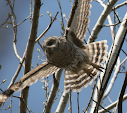
Yesterday at lunch I stopped by for a quick visit along the creek that runs adjacent to the Coal Creek Golf Course. With weather as mild as we have had the past few days visits there will soon be limited to those that I pay, and carry a bag of clubs along for. But yesterday for a few minutes I enjoyed the mild weather and the common birds of the area. As I watched my attention was drawn to first one, and then another female Downy Woodpecker as they worked through the same cottonwood tree. The one above shows what I see as the typical female Downy pattern. But this one stood out as being much lighter than normal.
As much as they would cooperate I tried to get comparison shots of the two. The lighter one shows an uppercase "T" pattern on the back of her head.

While the one with the more traditional pattern shows the full cross or lowercase "t".

Looking at the two birds on the monitor I was impressed by how a relatively small area of color difference gave the two birds dramatically different 'feel' when watching them in the trees. The lighter of the two gave off a much whiter impression than I would have expected for just having a more narrow and shorter crown stripe. Much like the M. C. Escher works and the and some of the optical illusion artwork out there show - I guess our perceptions are really conditioned to triggers.

While the one with the more traditional pattern shows the full cross or lowercase "t".

Looking at the two birds on the monitor I was impressed by how a relatively small area of color difference gave the two birds dramatically different 'feel' when watching them in the trees. The lighter of the two gave off a much whiter impression than I would have expected for just having a more narrow and shorter crown stripe. Much like the M. C. Escher works and the and some of the optical illusion artwork out there show - I guess our perceptions are really conditioned to triggers.
Having established what the difference was I did a bit of digging to see if this was common or an indicator of age, etc. I found this site: Variation in the head patterns of Downy (Picoides pubescens) and Hairy (P. villosus) woodpeckers. As far as I can gather the article was written by Kevin McGowan, and photography was credited to Kevin and Jay McGowan. It seems to indicate that the variations are normal, and a good means of identifying individuals. All I could get out of The Birds of North America Online, was:
"Female. Same as male except nape entirely black or black with white streaking or white nuchal-patch continuous with supercilium."
So I am left to wonder how often these lighter naped females occur, or if it is something that can be noticed more readily after one knows to look for it. I do know that I will be keeping a closer eye out for those Downys, and the next time I am back near Coal Creek I will be looking for the White-naped Lady.
Finally a House Finch for a bit of color. He and a group of his friends and rivals were all in a clump of bushes a bit further up stream. It is a favorite spot for them, I had a very similar shot last year. The location works as well, as there is good light coming from behind, and of course the red in the branches really seems to help blend with the red in their faces.
Finally a House Finch for a bit of color. He and a group of his friends and rivals were all in a clump of bushes a bit further up stream. It is a favorite spot for them, I had a very similar shot last year. The location works as well, as there is good light coming from behind, and of course the red in the branches really seems to help blend with the red in their faces.




No comments:
Post a Comment